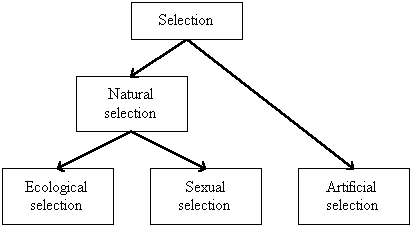Selection
| Part of a series on |
| Evolutionary biology |
|---|
 Diagrammatic representation of the divergence of modern taxonomic groups from their common ancestor. |
|
Natural history
|
|
History of evolutionary theory |
|
Fields and applications
|
|
Social implications |
|
In the context of evolution, certain traits or alleles of genes segregating within a population may be subject to selection. Under selection, individuals with advantages or "adaptive" traits tend to be more successful than their peers reproductively—meaning they contribute more offspring to the succeeding generation than others do. When these traits have a genetic basis, selection can increase the prevalence of those traits, because offspring will inherit those traits from their parents. When selection is intense and persistent, adaptive traits become universal to the population or species, which may then be said to have evolved.
Overview
Whether or not selection takes place depends on the conditions in which the individuals of a species find themselves. Adults, juveniles, embryos, and even eggs and sperm may undergo selection. Factors fostering selection include limits on resources (nourishment, habitat space, mates) and the existence of threats (predators, disease, adverse weather). Biologists often refer to such factors as selective pressures, also known as evolutionary pressures.
Natural selection is the most familiar type of selection by name. The breeding of dogs, cows and horses, however, represents "artificial selection", now commonly known as selective breeding, the key process in domestication. Subcategories of natural selection are also sometimes distinguished. These include sexual selection, ecological selection, stabilizing selection, disruptive selection and directional selection (more on these below).
Selection occurs only when the individuals of a population are diverse in their characteristics—or more specifically when the traits of individuals differ with respect to how well they equip them to survive or exploit a particular pressure. In the absence of individual variation, or when variations are selectively neutral, selection does not occur.
Meanwhile, selection does not guarantee that advantageous traits or alleles will become prevalent within a population. Another process of gene frequency alteration in a population is called genetic drift, which acts over genes that aren't under selection. But, this drift can't overcome natural selection itself, as it is a 'random sampling' process and Natural Selection is actually an evolutive force. In the face of selection even a so-called deleterious allele may become universal to the members of a species. This is a risk primarily in the case of "weak" selection (e.g. an infectious disease with only a low mortality rate) or small populations.
Though deleterious alleles may sometimes become established, selection may act "negatively" as well as "positively." Negative selection or purifying selection decreases the prevalence of traits that diminish individuals' capacity to succeed reproductively (i.e. their fitness), while positive selection increases the prevalence of adaptive traits.
In biological discussions, traits subject to negative selection are sometimes said to be "selected against," while those under positive selection are said to be "selected for," as in the scenario: During the severe drought affecting the Galapagos Islands, short beaks were selected against due to their relative inability to access tribulus seed nutrients. The following season, female finches displayed a change in their preferences for mates. During that mating season, greater sizes were selected for, as evident by the increase in the number of mating events per season for larger birds.
Types and subtypes

Patterns of selection
Aspects of selection may be divided into effects on a phenotype and their causes. The effects are called patterns of selection, and do not necessarily result from particular causes (mechanisms); in fact each pattern can arise from a number of different mechanisms. Stabilizing selection favors individuals with intermediate characteristics while its opposite, disruptive selection, favors those with extreme characteristics; directional selection occurs when characteristics lie along a phenotypic spectrum and the individuals at one end are more successful; and balancing selection is a pattern in which multiple characteristics may be favored. Diversifying selection occurs when rare variants are favored, and is similar to balancing selection.
Mechanisms of selection
Distinct from patterns of selection are mechanisms of selection; for example, disruptive selection often is the result of disassortative sexual selection, and balancing selection may result from frequency-dependent selection and overdominance.
See also
- Natural selection
- Sexual selection
- Artificial selection
- Evolution
Further reading
- Bell, Graham (1997). Selection: The Mechanism of Evolution. New York: Chapman & Hall. pp. 699 p. ISBN 0-412-05521-X. (2nd edition published in 2008 by Oxford University Press, 553 p., ISBN 0-19-856972-6)
| ||||||||||||||||||||||||||||||